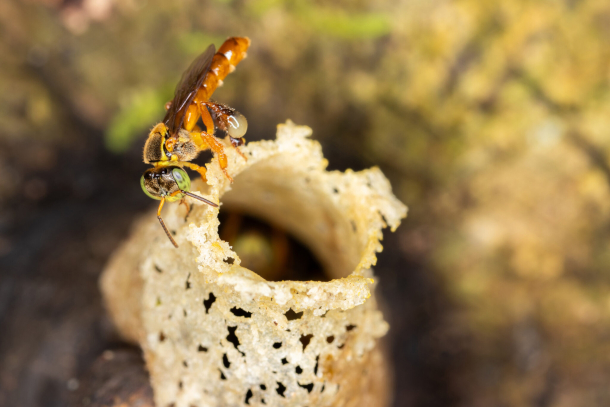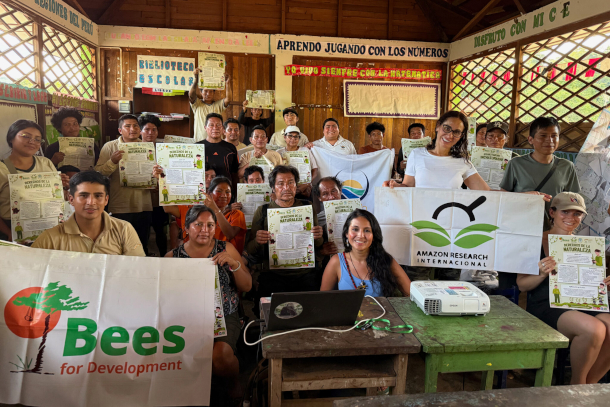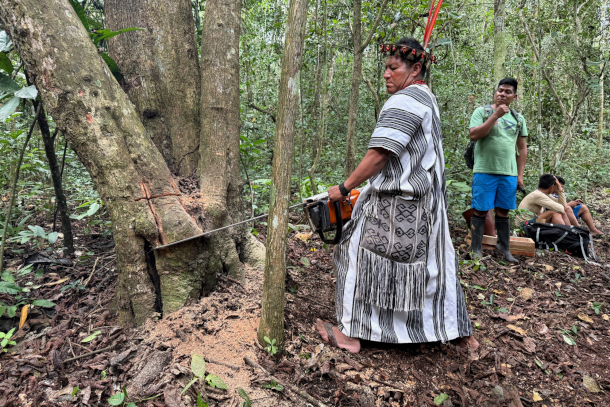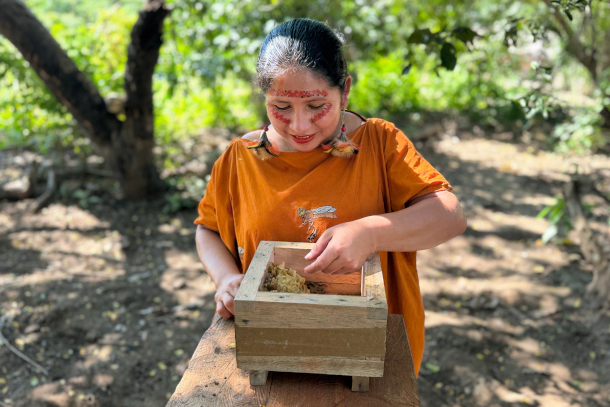Rights of Nature for Stingless Bees
Air Date: Week of November 14, 2025

Tetragonisca angustula, also known to locals as “angelitas”, or “little angels”. Here, a worker bee perches at the entrance of a wild nest. (Photo: Kathryn Naherny)
In the Peruvian Amazon, the Asháninka people have developed a symbiotic relationship with the local bees, which often lack stingers, and their honey. As habitat loss linked to climate change, forest fires, and deforestation threatens these pollinators and honey makers, a new and innovative law in Peru has granted these bees legal rights to help protect them and the indigenous people living with them. Reporter Teresa Tomassoni of our media partner Inside Climate News speaks with Host Aynsley O’Neill about the remarkable relationship between these bees and people.
Transcript
O’NEILL: Most of us are familiar with a few key facts about honeybees; they live in hives, they pollinate our food, and they sting. But hundreds of honeybee species don’t actually have that stinger we know from European honeybees, though they do still live in hives and pollinate crops. One of the places you can find these stingless bees is in the Peruvian Amazon, where the local Asháninka people have developed a sort of symbiotic relationship with the bees and their honey. But habitat loss linked to climate change, forest fires, and deforestation is posing an existential threat to these bees and indigenous communities. Teresa Tomassoni of our media partner Inside Climate News reported on a new, first-of-its-kind Peruvian law that gives these stingless bees legal rights to help protect them. She’s here to give us the buzz—Teresa, welcome to Living on Earth!
TOMASSONI: Thank you so much for having me.
O'NEILL: Teresa, tell us: what is a stingless bee? What sets these bees apart from the ones that we might be familiar with here in the United States?
TOMASSONI: Stingless bees, as the name suggests, either don't have stingers or have stingers that lack the ability to cause pain. Now that doesn't mean that they can't cause a little bit of harm now and then by biting. For the most part, these bees are very sweet and gentle, as the Asháninka people taught me. That's why they call one of the species angelitas, which means little angels. These stingless bees are key pollinators in the Amazonian ecosystems. They are contributing to the pollinization of at least 75% of agricultural crops in the region. One of the reasons that stingless bees are so not well known is they're tiny. They are often dismissed as flies or wasps. People don't know the major role that they play in pollinating the Amazon rainforest, the lungs of the world.

Some of the local indigenous communities in the Peruvian Amazon region sell stingless bee honey, which has been a part of their cultural medicinal practices for millenia. Two of the Peruvian scientists that Teresa Tomassoni interviewed, Rosa Vásquez Espinoza and Cesar Delgado, have found molecules in some of this honey with a number of medicinal properties, such as antibacterial, antifungal, and anti-inflammatory. (Photo: Teresa Tomassoni, Inside Climate News)
O'NEILL: And you were on the ground in Peru for about two weeks reporting on these bees. Can you tell us a little bit about that experience? You know, what's it like in that region of Peru? And who were some of the people that you actually spoke to there?
TOMASSONI: It was such an incredible experience. You know, I've been to the Amazon various times, but I've always been close to the Amazon River. We were actually in the central Peruvian Amazon. So we were in a region that's higher altitude. We were climbing up steep mountain paths, taking a moment to catch our breath as we're hiking uphill. The first time I saw the stingless bees happened in the Indigenous Asháninka community of Pichiquía, located along the Ene river. Doctora Rosa Espinoza, another entomologist who's Peruvian and Indigenous as well, César Delgado and some of the other Asháninka community members who have been practicing stingless beekeeping, which is called meliponiculture, arranged to facilitate a workshop in the community center where they showed off two bee boxes, which they called cajas in Spanish. And when I watched Doctora Rosa Espinoza and another woman featured in my article, Micaela Huaman, open that first hive, I was just amazed, because this hive looked very different from the honeycomb hives many of us have seen. This hive looked like a soccer ball riddled with kind of craters, almost like a planet. It was very globular and had these cavities. And what is super interesting is these stingless bees create these grape sized honey pods where they put their honey in, and that's where the honey is stored.
O'NEILL: And well, of course, I have to hear even more about this honey. I'm hoping you had a taste test that you can maybe share with us. What did you learn about this honey?
TOMASSONI: This honey is not like any honey that you would buy in a store, at least in the United States, right? This honey has a high water content. It's a little bit sour or acidic. Some of it is sweet. It's both sweet and sour. It goes down very easily. It doesn't stick to the back of your throat. It's not gooey. It goes down almost like a spoonful of medicine. And in fact, it is highly medicinal, which Indigenous people, the Indigenous Asháninka and other Indigenous groups throughout the Amazon have known for millennia. They've used it to treat a wide array of illnesses, and now scientists like Doctora Rosa Espinoza and César Delgado are just confirming that in their laboratories by doing these chemical analyses of these honeys and finding that they have anti-inflammatory, anti-bacterial, even anti-viral properties.

In 2025, Dr. Rosa Vásquez Espinoza, along with members of Amazon Research International and Earth Law Center, held a number of workshops on the Rights of Nature, particularly on their efforts to have the Peruvian government declare rights for stingless bees in the Amazon, alongside the Asháninka community. (Photo: Teresa Tomassoni, Inside Climate News)
O'NEILL: So, Teresa, tell us about the process of stingless beekeeping. How does it work exactly?
TOMASSONI: First you have to find the bees. Even in the best of conditions, it's not easy to find them. Their nests are not just hanging from trees. They're hidden inside the trees. They're hidden inside rotten logs. Some Indigenous peoples like this park ranger, Richar, listens for the bees. He can stand still in the forest and attune his ear into the sound of stingless bees, which I find quite incredible, and then follow that sound to the nest. But to access the nest even once you know where it is, is not easy. What I'm told is that historically, these nests were removed from a tree by chopping the entire tree down, which, as you can imagine, is not the most sustainable thing to do in the Amazon rainforest when we're trying to preserve habitat. And so the Asháninka people have developed a new method of basically cutting out a small section in the tree in a way that doesn't harm the tree permanently. They can detect where the nest is basically by knocking on the tree, again by sound. Once that nest is put into the bee box, they leave that box near the tree to, with the hopes that they're going to attract the bees back. They're going to then find this box with a little bit of honey around its entrance, and hope is that they enter and begin working in their hive once again. Once they see that the bees are thriving in that bee box, usually about a week after they've been removed from their natural habitat, they'll move that box to another area, either into a community or near a garden plot that they want more pollinators in.

Asháninka leader, César Ramos shows onlookers how to sustainably remove a wild stingless bee nest without fully cutting down the tree housing it. In the modern age, the Asháninka people and other local communities are cultivating stingless bees in wooden bee boxes, helping to multiply the hives and repopulate the species. (Photo: Teresa Tomassoni, Inside Climate News)
O'NEILL: And what about the role that they play in local culture? How do stingless bees, and I guess stingless beekeeping, fit into the local Indigenous communities?
TOMASSONI: The Asháninka people have a very strong relationship with the stingless bees. They call them their ancestors. They say we live with the bees. The bees live with us. And so for thousands of years, they say their ancestors have relied on the bees to provide honey that helps them treat a variety of illnesses. The Indigenous peoples really credit the stingless bees for helping them survive.
TOMASSONI: So your reporting talks about a new declaration that came out of the Peruvian government that actually gives these bees legal rights. Now, for those of us who might not know why this is, how would you explain what it means for an insect to be granted legal rights like this?
TOMASSONI: So before last year, the Peruvian government didn't even acknowledge that stingless bees existed as a species within their country. They had no legal protections whatsoever, even though European honeybees, apis mellifera, did. So, what Doctora Rosa Espinoza, Earth Law Center, other scientists in the Asháninka people really advocated for was first a national law that recognized these bees exist in our country, but then they wanted to strengthen that law to go a step further by acknowledging these insects as inherent holders of legal rights. And so this next step is based on a growing “rights of nature” movement, which is a legal and philosophical framework that is really meant to strengthen and reframe how we protect the environment. And so this new declaration actually was developed in collaboration with Asháninka leaders and community members. It also mentions that the indigenous people's rights are inextricably connected with those of the stingless bees. They acknowledge that the indigenous people's culture, their spiritual beliefs, are very much intertwined with the well-being of the stingless bees.
O'NEILL: And what kind of threats are they facing that really inspired this push to protect them?
TOMASSONI: As we know throughout the Amazon, deforestation is one of the number one threats to habitat and species. We are seeing illegal logging happening rampantly throughout the Amazon, but particularly in this region of Junín. We're seeing large areas of land clearing happening to make way for other agriculture, cattle grazing, even illicit coca crops, so their habitat is being largely wiped out. And then we have climate change, which is raising temperatures in these typically cooler environments, as I mentioned, in this part of the Amazon, forcing the bees to move higher, further away from communities that are used to depending on them, and harvesting their honey for medicine, for example.

Asháninka stingless beekeeper Micaela Huaman Fernandez inspects a hive of Tetragonisca angustula bees. (Photo: Teresa Tomassoni, Inside Climate News)
O'NEILL: And so what kind of impact do you see these new legal rights having, not just on the bees themselves, but in the local culture?
TOMASSONI: What I'm hearing from Rosa Espinoza, for example, is that the government of Satipo will implement this local law by designating or funneling funds to local communities to be trained in meliponiculture, in the practice of stingless beekeeping. But the sources of income are very limited in this region, and so by training them in stingless beekeeping, by giving them the materials, could open up a whole new opportunity for earning income in this particular area. We're already seeing this happen in other regions of the Peruvian Amazon. The other part of this implementation is very much focused on restoration. So the scientists, the Asháninka leaders, are really hoping that investments will be made in restoring areas that have been degraded by illegal logging, by wildfires.
O'NEILL: Well, so Teresa, some might say, okay, cool, fun facts we now know that a stingless bee exists, but what's the impact here? What's the importance here? Why would you say that people globally should care about these stingless bees?
TOMASSONI: I think it's important to note that we are facing a global crisis in losing our pollinators, from our butterflies to our honeybees to the stingless bees in the Peruvian Amazon. Losing our pollinators affects us all. This affects the agricultural crops that we depend on for our food. It affects the availability of medicinal plants, and so the stingless bee is a unique case study in which to set our eyes on and learn from and acknowledge what can happen when their habitat disappears. When it's cleared, those pollinators disappear, and then what happens? We lose those medicinal plants. We lose the potential to pollinate the crops that large populations also depend on throughout the region.
O'NEILL: Teresa Tomassoni is a journalist with Inside Climate News. Teresa, thank you so much for joining me today.
TOMASSONI: Thank you so much for having me.
Links
Inside Climate News | “Defending Stingless Bees in the Peruvian Amazon”
Living on Earth wants to hear from you!
Living on Earth
62 Calef Highway, Suite 212
Lee, NH 03861
Telephone: 617-287-4121
E-mail: comments@loe.org
Newsletter [Click here]
Donate to Living on Earth!
Living on Earth is an independent media program and relies entirely on contributions from listeners and institutions supporting public service. Please donate now to preserve an independent environmental voice.
NewsletterLiving on Earth offers a weekly delivery of the show's rundown to your mailbox. Sign up for our newsletter today!
 Sailors For The Sea: Be the change you want to sea.
Sailors For The Sea: Be the change you want to sea.
 The Grantham Foundation for the Protection of the Environment: Committed to protecting and improving the health of the global environment.
The Grantham Foundation for the Protection of the Environment: Committed to protecting and improving the health of the global environment.
 Contribute to Living on Earth and receive, as our gift to you, an archival print of one of Mark Seth Lender's extraordinary wildlife photographs. Follow the link to see Mark's current collection of photographs.
Contribute to Living on Earth and receive, as our gift to you, an archival print of one of Mark Seth Lender's extraordinary wildlife photographs. Follow the link to see Mark's current collection of photographs.
 Buy a signed copy of Mark Seth Lender's book Smeagull the Seagull & support Living on Earth
Buy a signed copy of Mark Seth Lender's book Smeagull the Seagull & support Living on Earth

